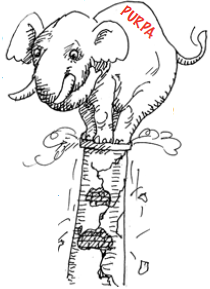 Electricity markets are failing. They are failing because they cannot overcome the distortions heaped on them by layer upon layer of regulation.
Electricity markets are failing. They are failing because they cannot overcome the distortions heaped on them by layer upon layer of regulation.
Recall recent history. Virtually every state electricity deregulation program began with guaranteed electricity rate reduction or rate protection for most consumers, a strange way to inject competition based on price signals but a great way to later conclude that competition lowers rates. Let’s also remember that the vast majority of ratepayers were not clamoring for deregulation; the Electricity Consumers Resource Council (Elcon) did that.
Actually, industry competition started with the Public Utility Regulatory Policies Act (Purpa) mandate for utilities to purchase electricity from “qualifying facilities” at “avoided cost.”
 Today, baseload power has declining value. CO2-free nuclear and modern coal plants can’t effectively bid into ISO markets. Under threat of closure, nuke owner/operators are lobbying for subsidies which allow them to at least pay the bills. Net-metered rooftop PV customers are being subsidized at the expense of all other ratepayers, most of whom can’t afford PV. Non-utility renewable project developers are driving towards zero marginal-cost facilities (no fuel costs, little O&M) with generous production and investment tax credits and little obligation to firm their deliveries.
Today, baseload power has declining value. CO2-free nuclear and modern coal plants can’t effectively bid into ISO markets. Under threat of closure, nuke owner/operators are lobbying for subsidies which allow them to at least pay the bills. Net-metered rooftop PV customers are being subsidized at the expense of all other ratepayers, most of whom can’t afford PV. Non-utility renewable project developers are driving towards zero marginal-cost facilities (no fuel costs, little O&M) with generous production and investment tax credits and little obligation to firm their deliveries.
The environmental regulatory gauntlet around coal, with help from historically low natural gas prices, is doing its job, forcing older, smaller coal plants into retirement. ISOs offer capacity payments, response flexibility products, and ancillary services payments because market price signals fail to provide proper incentives to build new capacity. FERC had to offer adders to capital-investment rates of return and a program called “Multi-Value Projects” to support regional transmission.
Even the best spreadsheet models can’t make a pretty picture of investing in a multi-decade asset based on a day-ahead or hourly price signal. To boot, there is barely any real-time price margin to exploit.
At the meter, most customers still don’t have time-of-use rates for making rational decisions about energy use based on price signals. Meanwhile, distribution utilities subsidize efficiency products, and the unenviable position of investing in less use of their product.
As Mark Glaess, consultant and former executive director of the Minnesota Rural Electric Assn, recalls, “In the 1990s, Minnesota electric cooperatives offered green energy, 3% of the customer base thought that was a good idea, and the legislature extrapolated it to a 25% renewable mandate.”
Today’s ISO is one giant NERC-policed regional transmission utility, a vast bureaucracy intermediating wholesale electricity among distribution utilities, saddled with the obligation to serve, and various classes of generators separated by regulatory dislocations into buckets ranging from highly desirable to untouchable.
Maybe it’s time to start with the ratepayer, actually listen, then work backwards into the supply chain.



